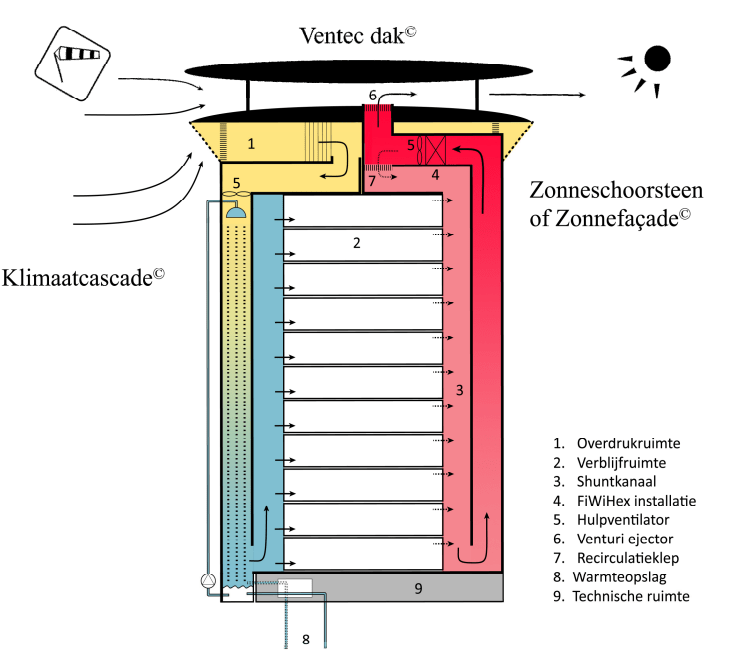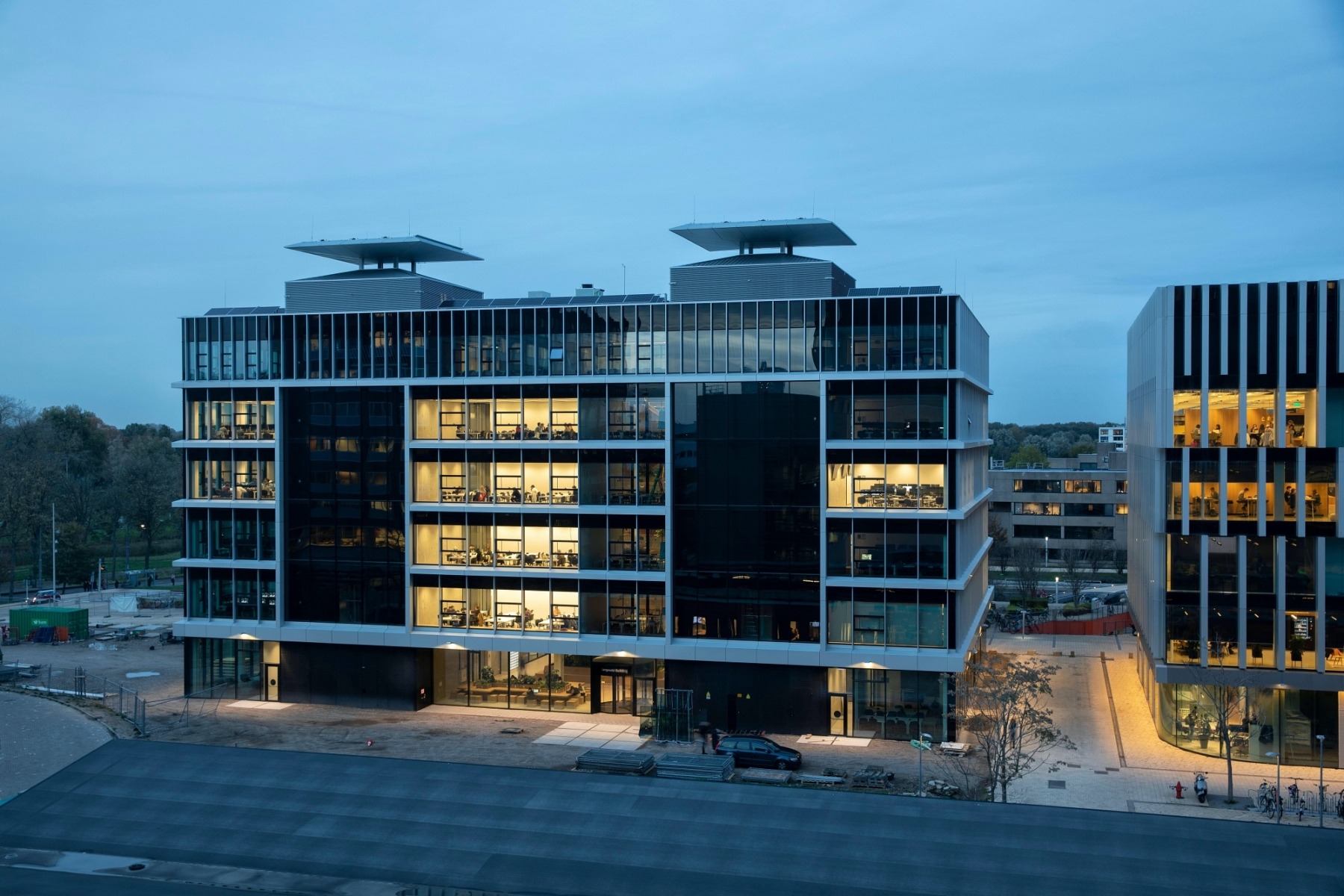The two venturi roofs on the Langeveld building at the Erasmus University are hallmarks of the natural ventilation system EWF. (Photo: Eric Fecken)
The new education building GO Zuid that TU Delft is planning to build is supposed to be the centrepiece of the southward expansion of the campus. A natural air conditioning system would have fit in well with the sustainable concept, but was scrapped when the objections outweighed the green intentions. The following is a reconstruction of the events starring an 89 year old alumnus.
This article in 1 minute
- TU Delft is planning a new generic education building on the south campus called GO Zuid.
- It is to be healthy, energy and CO2 neutral, circular and nature-inclusive.
- The Earth Wind & Fire EWF air conditioning concept, invented at TU Delft, was to be the first choice for its air conditioning system.
- But this changed in early 2023 after an external report by Nelissen consultants.
- Ben Bronsema, the senior inventor (89) of the EWF system, is dismayed and dissected Nelissen’s report.
- But TU Delft experts, including Philo Bluysen and Andy van den Dobbelsteen, are following Nelissen’s lead and are dropping the EWF concept.
- Bronsema is further working on his idea in the TKI Urban Energy knowledge consortium and aims to renovate the Palace of Justice. He is leaving the ‘debacle with GO Zuid’ behind him.
It is late January 2024 when Dr Ben Bronsema (89) goes to his computer to make his displeasure known to the world. Two months earlier, he had sent an 11 page argumentation to TU Delft to prove the superiority of EWF, his natural air conditioning system, despite a critical expert report. He argued that EWF would fit perfectly in GO Zuid (South), the new generic education building. It is to be the central building in the southern extension of the campus.
A response from the client, TU Delft’s Campus Real Estate (CREFM), failed to materialise. So Bronsema typed a reminder on 26 January 2024: ‘Unfortunately, I have not received a response and am wondering what this means. Are you still brooding on a response or has my plea been foolishly ignored?’
Earth, Wind & Fire
After a working life in air conditioning design, Bronsema had contacted TU Delft in 2005 to pitch his innovative idea for a natural climate system. Bronsema was no stranger to TU Delft – he had previously been contracted as a lecturer on air con systems. In 2013, he received his PhD from sustainability professor Prof. Peter Luscuere and Naturalis architect Prof. Fons Verheijen (both from the Faculty of Architecture and the Built Environment) on a climate system that derives its energy from sun and wind. ‘Earth, Wind & Fire’ Bronsema had called his concept, or EWF for short.
The system became the first choice for GO Zuid, but in 2023 doubts had arisen following an expert report by Nelissen Ingenieursbureau bv, an engineering firm.
Natural air conditioning

What is so appealing about Bronsema’s natural air con? For his thesis, he created a schematic cross-section and an accessible explanation. He likes to talk about ‘Air conditioning Powered by Nature’. This starts with the ‘Venturi roof’ which captures outside air and pushes it through a shaft where it is washed and pushed down by shower heads, the climate cascade. There are ventilators for when there is not enough wind for natural circulation.
From the basement, the air passes through heat exchangers to reach the target temperature, then rises through a second shaft to the accommodation areas. A third shaft could be built on the south side of the building to capture solar heat: the solar chimney. As the heated air rises, it draws used air from the building. When it is windy, the pressure created by the Venturi roof enhances the air flow.
Bronsema’s EWF system has been installed twice before
The absence of filters means that little pressure is needed to supply fresh air to the building. Usually, the sun and/or wind suffice as driving forces. Ventilators are rarely needed, or if so, to a very limited extent. This ensures low energy consumption. In fact, the EWF system produces energy through heat extraction from the solar chimney and electricity production from solar panels on the Venturi roof. Theoretically, the EWF climate system could be energy-neutral throughout the year on average. In practice, ventilation experts assume a 50% lower energy consumption compared to conventional air-conditioning systems.
Bronsema’s EWF system has been installed twice before. In 2019, the ecological Four Elements Hotel in Amsterdam was the first. Three years later, Erasmus University opened the Langeveld Building, a multifunctional education building. The University’s Erasmus Magazine noted complaints about accessibility, but never about the indoor climate. GO Zuid could have been the third time, but the client decided otherwise.
Risks
Ella Dongstra, the Communications Advisor at TU Delft Campus Real Estate (CREFM), confirms, when asked, that ‘TU Delft chose not to use the Earth, Wind & Fire principle.’ This was preceded by research by TU Delft itself and Nelissen, the external engineering consultant. Their report, issued on 14 March 2023, concluded ‘that the EWF principle cannot meet important safety and health criteria specified in the Programme of Requirements’.
In the report, Nelissen compares the EWF system to a traditional ventilation system and to a low-speed ventilation concept. It first states the advantages of the EWF concept, which include:
- visible sustainability through the eye-catching Venturi roofs; and,
- use as a ‘Living Lab’ to conduct research to improve the EWF concept.
However, Nelissen’s list of risks is longer. It includes the following.
- Air filtration is of concern. A particulate filter cannot be applied and if the nozzles in the climate cascade are off, then no outside air is filtered.
- EWF’s energy saving compared to standard ventilation is only 11%. EWF does save on fans, but a standard installation has better heat recovery, which minimises the difference.
- If the building is extended, it is uncertain whether EWF can still be used. A third climate cascade would definitely have to be added.
- Waterproofing, semi-annual cleaning and legionella prevention are points of concern when a climate cascade system is in permanent operation.
Discussion

Nine months later, Bronsema sends his rebuttal, an 11-page argument, in which he addresses the main risks: the supposedly disappointing energy savings and the doubts about air filtration. On the energy savings, Bronsema writes that Nelissen failed to include humidification in its calculations. In regular air treatment systems, this is an energy-intensive component, but this is not the case with the EWF, as humidification is an integral part of it.
On air filters in regular systems, Bronsema says that they are mainly designed to prevent contamination of various components of the installation. Air purification would be necessary to keep the plant’s components functioning optimally during its lifetime. Air filters serve the equipment rather than the inhabitants. Responding to Nelissen, Bronsema says that ‘since many of these components are absent from the EWF concept, air filters are unnecessary’.
In Bronsema’s concept EWF the climate cascade washes dust from the incoming air. Should the need arise, the air shower system can also be combined with electrostatic dust filters that have low air resistance, he adds.
Fresh air
Delta presented Bronsema’s arguments to indoor environment expert Prof. Philo Bluysen (Architecture and the Built Environment). She is not convinced. She is familiar with the view that air filters should mainly protect equipment, but thinks that this idea is outdated. “We now know that we need to clean outside air first. You would not believe what my lab’s intake filters look like after a few months.” Her views can also be found in the Programme of Requirements (in Dutch) for Fresh Schools 2021, which prescribes the use of fine dust filters as a minimum requirement.
He calls the Fresh Schools requirements ‘a killer’ for innovative ventilation systems
Can Bronsema’s filterless concept still be applied to educational buildings after 2021? He himself seems to think not. He calls the Fresh Schools programme of requirements ‘a killer’ for innovative ventilation systems. ‘Even the socially widely appreciated natural ventilation is made impossible’, he writes in an email to Delta (26 January 2024).
Professor Andy van den Dobbelsteen (Architecture and the Built Environment) does not see air filtration in such black and white terms. As the TU Delft Sustainability Coordinator, he is involved in the design of GO South and he was also Bronsema’s co-supervisor for his PhD research. “I don’t think air filtration is the problem,” says Van den Dobbelsteen. “It can be solved technically by using filters and additional fans. That is more energy intensive, but the health gains outweigh the disadvantages. Both energy reduction and health requirements are important, but building standards should be adhered to.”
Unsuitable building
The real problem with the EWF system lies elsewhere, says Van den Dobbelsteen. As a sustainable climate concept, he says EWF is especially suitable for relatively tall buildings. Only then, in his view, do you get sufficient draught through the solar chimney and can the climate cascade function properly. The Venturi roof would also fare better on a tall building.
But the GO Zuid education building will be relatively low and wide. Several consultants assure Van den Dobbelsteen that the EWF system will not work adequately there, he says. “Then an additional system would have to be put in place to refresh enough air. This would negate the advantages of EWF, such as natural air circulation and low energy consumption.”
Van den Dobbelsteen would still like to have a building with EWF ventilation on campus
Does Van den Dobbelsteen still see a future for the EWF concept on campus? As the Sustainability Coordinator, he has an impressive list of requirements for buildings on campus: health, energy and CO2 neutral, circular and nature-inclusive. “Meeting these requirements is not easy, but this is a new era where all this just has to be done,” he says.
As Bronsema’s co-supervisor, Van den Dobbelsteen would still like to have a building with EWF ventilation on campus, he says. Both as a statement and as a living lab. He is now pinning his hopes on the upcoming renovation of the Civil Engineering and Geosciences buildings, or the Electrical Engineering, Mathematics and Computer Sciences tower. “These are taller, which is beneficial for EWF,” he says.
Going hybrid
Both Bluysen and Van den Dobbelsteen then mention hybrid ventilation systems combining elements of EWF with particulate filters, fans and air cleaners. “That’s where we need to go,” says Bluysen. “It is never wise to bet on one horse.”
Yet even at Go Zuid, it is not quite the end of the road for EWF. Van den Dobbelsteen says he is pushing for a more sustainable air conditioning system (than conventional air conditioning, Eds.) that combines elements of EWF with conventional components. “There are other sustainable air-conditioning systems besides EWF, and Ben knows that too,” says Van den Dobbelsteen.
Bronsema has now set his sights on forthcoming projects. A research proposal for EWF was honoured this month by the TKI Urban Energy knowledge platform. In it, Bronsema’s EWF lab will be working with Windesheim University of Applied Sciences and companies such as the BAM construction company and Saint-Gobain glass construction company. Their goal is to design and build an EWF-based ventilation system for the renovation of the Palace of Justice.
By participating in the TKI Urban Energy, writes Bronsema, ‘debacles like with the Generic Education Building Zuid can be avoided in the future. Cold comfort perhaps, but still.’
The EWF principle in 5 minutes.
- More about EWF on the EWF-lab website (in Dutch)
Do you have a question or comment about this article?
j.w.wassink@tudelft.nl


Comments are closed.